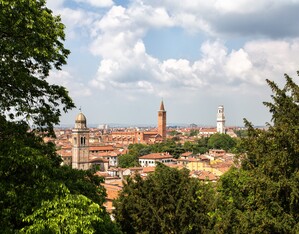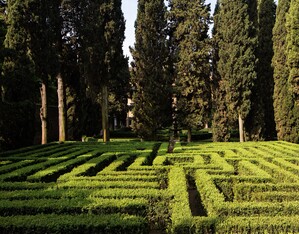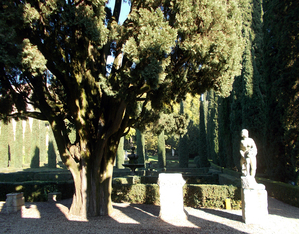With its reputation and magnificent views out over the city, this formal garden from the second half of the 16th century is in the style of a Tuscan garden, with statues, fountains, caves, pavillions, a cedar grove and a boxwood maze, and was an attraction to “Grand Tour” travellers from all over Europe.
This plot of land at the foot of San Pietro Hill was originally a farm belonging to the Giusti family of Tuscan origin (in the 18th century, the family added the epithet “del Giardino” to its surname). In the 16th century, at the behest of humanist Agostino Giusti, it was converted into an impressive palazzo accessed from the rear courtyard enclosed by crenellated walls. The garden was built between 1565 and 1580, and modified a number of times over the centuries. The initial arrangement of nine geometric squares, subdivided by simple orthogonal boxwood beds, was rearranged in 1765 into an ornate “French” design, complete with statues of mythological subjects. The famous labyrinth, thought to be the brainchild of Agostino’s son, Gian Giacomo, was redesigned in 1786 by Veronese architect Luigi Trezza. The labyrinth was recreated between 1970 and 1972 under the direction of Cesare Benciolini, when the boxwood was replaced by privet. A long avenue of cypress trees, including the monumental tree so admired by Goethe (recently uprooted by a huge storm), runs all the way through the garden, ending in the “Mirror Cave” decorated with shells, stalactites and mirror slabs, and topped by a large mask carved into the rock from which, on special occasions, tongues of fire and smoke once issued. From here, a spiral staircase carved out of a bell tower leads to the upper part of the garden. The belvedere above the mask offers some of the most stunning views of the city of Verona. The greenhouses beyond the formal enclosure are filled with lemon trees planted in the ground and trained on espaliers. A grove concealing small caves carved into the tuff runs down the slope. The “Palazzina di Venere”, a suggestive belvedere/loggia frescoed by Orazio Farinati in the late 1500s, is particularly worthy of note. The upper northern part of the garden is bordered by walls from the epoch of Theodoric.




